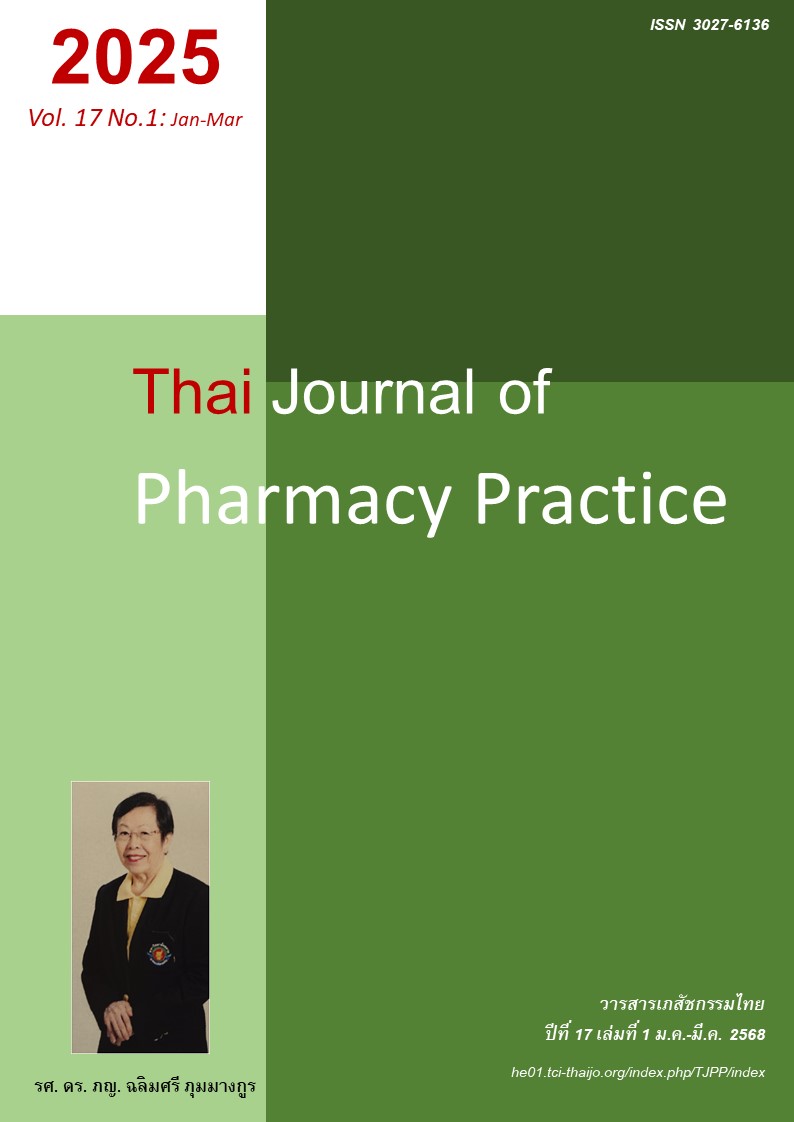ลักษณะของฉลากบรรจุยาในคลินิกเวชกรรมเอกชน: การศึกษาเชิงตัดขวางในอำเภอเมือง จังหวัดอุดรธานี
Main Article Content
บทคัดย่อ
วัตถุประสงค์: เพื่อศึกษาความชุกของการแสดงฉลากบรรจุยาครบถ้วนตามที่กฎหมายกำหนด รวมทั้งรายละเอียดการแสดงฉลากบรรจุยาของคลินิกเวชกรรมในอำเภอเมือง จังหวัดอุดรธานี วิธีการ: งานวิจัยนี้เป็นการศึกษาเชิงตัดขวางที่เก็บข้อมูลด้วยแบบสอบถามออนไลน์ร่วมกับการลงพื้นที่สำรวจระหว่างวันที่ 1 กรกฎาคม พ.ศ. 2565 ถึง 10 กรกฎาคม พ.ศ. 2566 ในคลินิกเวชกรรมทั่วไปและเวชกรรมเฉพาะทางที่ขึ้นทะเบียนก่อนวันที่ 16 มีนาคม พ.ศ. 2565 และตั้งอยู่ในเขตอำเภอเมือง จังหวัดอุดรธานี การศึกษาเก็บข้อมูลทั่วไปเกี่ยวกับผู้จ่ายยา คลินิก และฉลากยาที่ส่งมอบจริงให้กับผู้ป่วย ได้แก่ 1) ช่องทางติดต่อคลินิก 2) ชื่อผู้ป่วยและวันที่จ่ายยา 3) ชื่อยา 4) รูปแบบ ความแรง 5) วิธีการใช้ 6) ข้อบ่งใช้ 7) คำเตือน ข้อควรระวัง และ 8) วันหมดอายุ ผลลัพธ์ในการศึกษาประกอบด้วย การแสดงฉลากยาครบถ้วนตามที่กฎหมายกำหนด การแสดงองค์ประกอบสำคัญของฉลากยาครบถ้วน และจำนวนองค์ประกอบบนฉลากบรรจุยา ผลการวิจัย: จากคลินิกที่สำรวจ 89 แห่ง พบเพียงร้อยละ 3.4 ที่เขียนฉลากบรรจุยาครบถ้วนตามที่กฎหมายกำหนด และมีเพียงร้อยละ 12.4 ที่ฉลากบรรจุยามีองค์ประกอบสำคัญครบถ้วน โดยองค์ประกอบที่มีการระบุไว้ส่วนใหญ่ ได้แก่ วิธีใช้ยา (ร้อยละ 89.9) รายละเอียดของสถานพยาบาล (ร้อยละ 82.0) วันหมดอายุ (ร้อยละ 57.3) และชื่อยาภาษาอังกฤษ (ร้อยละ 56.2) ผลการประเมินแต่ละองค์ประกอบบนฉลากโดยพนักงานผู้ปฏิบัติงานในคลินิกและเจ้าพนักงานบังคับใช้กฎหมายพบว่ามีความสอดคล้องกันต่ำ (kappa statistics -0.03 ถึง 0.38) นอกจากนี้การมีผู้ประกอบวิชาชีพเวชกรรมมากกว่าหนึ่งคนเป็นปัจจัยที่สัมพันธ์กับการมีจำนวนองค์ประกอบบนฉลากที่เพิ่มขึ้น (adjusted beta-coefficient 1.29; 95% CI: 0.42 ถึง 2.17) และเพิ่มแนวโน้มการเขียนฉลากยาที่มีองค์ประกอบสำคัญครบถ้วน (adjusted odds ratio 42.50; 95% CI 2.96 ถึง 610.86) สรุป: คลินิกเวชกรรมที่สำรวจส่วนใหญ่ยังเขียนฉลากบรรจุยาไม่ครบถ้วนตามที่กฎหมายกำหนด การส่งเสริมความเข้าใจของผู้ปฏิบัติงานเกี่ยวกับองค์ประกอบที่ต้องแสดงบนฉลากบรรจุยาน่าจะเป็นจุดเริ่มต้นการดำเนินงานที่สำคัญก่อนที่กฎหมายจะถูกบังคับใช้อย่างจริงจังต่อไปในอนาคตอันใกล้
Article Details

อนุญาตภายใต้เงื่อนไข Creative Commons Attribution-NonCommercial-NoDerivatives 4.0 International License.
ผลการวิจัยและความคิดเห็นที่ปรากฏในบทความถือเป็นความคิดเห็นและอยู่ในความรับผิดชอบของผู้นิพนธ์ มิใช่ความเห็นหรือความรับผิดชอบของกองบรรณาธิการ หรือคณะเภสัชศาสตร์ มหาวิทยาลัยสงขลานครินทร์ ทั้งนี้ไม่รวมความผิดพลาดอันเกิดจากการพิมพ์ บทความที่ได้รับการเผยแพร่โดยวารสารเภสัชกรรมไทยถือเป็นสิทธิ์ของวารสารฯ
เอกสารอ้างอิง
Institute for Population and Social Research. Thai population health report 2021: COVID-19 the great global threat. Nakhon Pathom: Institute for Popula- tion and Social Research, Mahido University; 2021.
Department of Health Service Support Ministry of Public Health. Non-overnight sanatoriums (clinic) [online]. [cited 2022 May 22]. Available from: statv2. nic.go.th/Health/05030602_02.php
Shayakul C, Chongtrakul P, Wananukul W, Bunupu radah P, Kanjanarat P, Yotsombut K, et al., editors. Rational drug use hospital manual. Nonthaburi: Printing house of the Agricultural Co-operative Federation of Thailand; 2015.
Notification of Ministry of Public Health on standard of services of sanatorium regarding drug labeling B.E. 2565. Royal Gazette No. 139 Special, part 86A (Mar 16, 2022).
Dhanasettakorn M, Bunchuailua W. Provision of drug information for patients of non-overnight sanatoriums in Chonburi. Thai Journal of Pharmacy Practice 2017; 9: 15–26.
Wade A. Study size. Sex Transm Infect. 2001; 77: 332–4. doi: 10.1136/sti.77.5.332.
Landis JR, Koch GG. The measurement of observer agreement for categorical data. Biometrics 1977; 33: 159–74.
Kirkwood BR, Sterne JAC. Essential medical statis- tics. 2nd ed. Malden, Massachusetts: Blackwell Science; 2003.
Vatcheva KP, Lee M, McCormic JB, Rahbar MH. Multicollinearity in regression analyses conducted in epidemiologic studies. Epidemiology 2016; 6: 227. doi: 10.4172/2161-1165.1000227.
Tungsawatdirat T, Kongchai K, Maneemai O art. Behaviours and attitudes of medication label writing according to the good pharmacy practice of northern community pharmacists. Thai Bulletin of Pharmaceu- tical Sciences. 2018; 13: 117–27.
Nontaleeruk P, Intharapong S, Plianbangchang P. Community pharmacists’ medicine labeling behavior in Bangkok and its metroplitan areas. Naresuan University Journal 2006; 14: 27–34.
Dockpong D. Drug information for patients in private clinics and drugstores in Khukhan district, Si Sa Ket province [master thesis]. Khonkaen: Khonkaen University; 2013.


